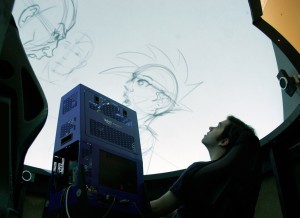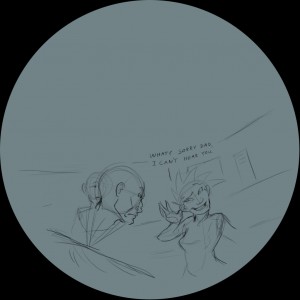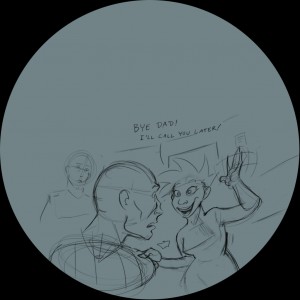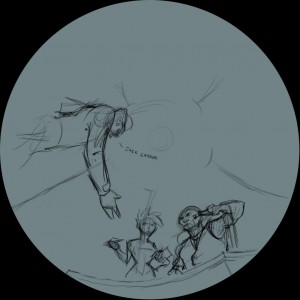 The first blog post I made I talked about making storyboards for the dome. To give a better idea what I’m doing, Jay was kind enough to take a picture of me in the process of making one of the boards for our next show solar system show.
The first blog post I made I talked about making storyboards for the dome. To give a better idea what I’m doing, Jay was kind enough to take a picture of me in the process of making one of the boards for our next show solar system show.
What’s interesting about this process in the dome, is not only the challenege of imagining the scene and positioning the characters in the false 3D space, but the relationship and staging of the characters in the 2D sense. What my good friend and collegue Pete would say is that even with using 3d software like Maya or even 3d comps in After Effects, you’re still creating a flat image for film.
I apply that philosophy when boarding in the dome, trying to make the board pleasant across the whole surface for layout and staging.
There are some advantages and disadvantages to making boards in the dome versus flat, uncurved surface. An obvious disadvantage is that having access to a projector and dome is not a readily available option. Drawing on the dome also takes a little getting used to. What we’re seeing in the picture is myself drawing in the open source program Gimp, on a 1024×768 canvas, to match the projector’s resolution. When in full screen mode, I’m able to adjust the positioning so that it covers the whole dome surface. Since the projector has a correct distortion to fit the curved surface, I need to match that while drawing in Gimp. The result is a correctly distorted image, that will show up properly on the dome. Here’s a couple of examples of finished frames.
In this sequence our heroine is hanging up on her holographic father. This sort of board is a little more flat than what they normally would look like, as there aren’t any extreme angles. It would be very feasible to even make boards like these without the use of a dome to project on, just needing to remember where the front, right, left, and back positions are.
This is a more extreme example. This particular board would best be done inside the dome environment.
The advantages are obvious, there is no guesswork, and the director would get to know exactly what the shots will look like before its brought further down the production line. A frequent question asked when boards are made on a 4:3 or widescreen is, “Well what’s the back look like?” This method is a way to show what that back actually would look like, or a close aproximation to.





2 Responses to “Storyboard Continuation”
Nancy Griffn
You appear to be floating,Jim. Great work!
Nancy
Betty Toole
How exciting! I can’t wait for Kaitlyn to see this. Great Job.
Wanted you to know that every year the 4th grade teacher asks Rebecca to bring “Patrick Henry – Quest for Freedom” to school. Keep up the good work. Betty